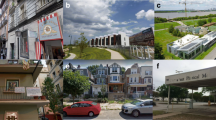Abstract
Conventional analyses on real estate pricing strategy concentrate on the impact brought about by the existence of various physical and environmental attributes such as location, view and amenity effects. For each of these variables, the extent of impact across different property types seems to be rather constant. This, however, may not hold when it comes to a specific variable—size, especially in terms of per-square-foot price of the subject property. While it is a general perception that larger real estate should command a higher total price because of the simple logic of aggregating the unit price from a larger floor area, in some sub-sectors of the property market such as the retail property sector, it is not uncommon to find that larger shops tend to have relatively smaller unit price/rent compared to smaller shops, other things being equal. In this paper, the authors would like to show that in the residential sector in Hong Kong, this common market practice is being reverted when we find that larger residential flats command relatively higher per-unit price (and hence also the overall price of the subject property), making larger residential flat proportionately more expensive.
Similar content being viewed by others
References
Alonso, W. (1964). Location and land use. Cambridge: Harvard University Press.
Arimah, B. C. (1992). An empirical analysis of the demand for housing attributes in a third world city. Land Economics, 68(4), 366.
Assessor for Central Scotland. (2010). 2010 Revaluation–valuation of shops: Local report. (http://www.saa.gov.uk/resources/268402/shopslocal2010.pdf) pp. 1–17.
Ayrshire Valuation Joint Board. (2010). Revaluation 2010 valuation instructions. (http://www.ayrshire-vjb.gov.uk/2010%20-%20Practice%20Note%20AVJB%20Local%20Instructions%20Shops.pdf) pp 1–8.
Bond, P. H., & Brown, P. K. (2002). Rating valuation: Principles and practice (pp. 202–203). Oxford: EG Books.
Brotman, B. A. (1990). Linear and nonlinear appraisal models. The Appraisal Journal, 58(2), 249–253.
Bucchianeri, G. W. (2011). The anatomy of a housing bubble: Overconfidence, media and politics. Available at SSRN: http://ssrn.com/abstract=1877204.
Case, B., & Quigley, J. M. (1991). The dynamics of real estate prices. Review of Economics and Statistics, 73(3), 50–58.
Chau, K. W., Wong, K. S. K., & Yiu, E. C. Y. (2004). The value of the provision of a balcony in apartment in Hong Kong. Property Management, 22(3), 250–264.
Choy, L. H. T., Mak, S. W. K., & Ho, W. K. O. (2007). Modeling Hong Kong real estate prices. Journal of Housing and the Built Environment, 22(4), 359–368.
Hayward, R. E. H., & Rees, W. H. (Eds.). (2000). Valuation: Principles into practice (5th ed.). London: Estate Gazette.
Kendree, J. M., Rauch, D. A. (1990). Toward a theory on the effects of view and size on the price of real estate, paper presented at the American Real Estate Society annual meeting, Lake Tahoe, NV.
Mok, H. M. K., Chan, P. P. K., & Cho, Y. S. (1995). A hedonic price model for private properties in Hong Kong. Journal of Real Estate Finance and Economics, 10, 37–48.
Monkkonen, P., Wong, K., & Begley, J. (2012). Economic restructuring, urban growth, and short-term trading: The spatial dynamics of the Hong Kong housing market, 1992–2008. Regional Science and Urban Economics, 42(3), 396–406.
Peng, R., & Wheaton, W. C. (1994). Wheaton effects of restrictive land supply on housing in Hong Kong: An econometric analysis. Journal of Housing Research, 5(2), 263–291.
Rodriguez, M., & Sirmans, C. F. (1994). Quantifying the value of a view in single-family housing markets. Appraisal Journal, 62, 600–603.
Scottish Assessors Association. (2005). Commercial properties committee: Valuation of shops, revaluation 2005. Practice Note, 40, 1–4.
Sirmans, G. S., Sirmans, C. F., & Benjamin, J. D. (1989). Determining apartment rent: The value of amenities, services, and external factors. Journal of Real Estate Research, 4(2), 33–34.
So, H. M., Tse, R. Y. C., & Ganesan, S. (1997). Estimating the influence of transport on house prices: Evidence from Hong Kong. Journal of Property Valuation and Investment, 15(1), 40–47.
Wolverton, M. L. (1997). Empirical study of the relationship between residential lot price, size and view. Journal of Property Valuation and Investment, 15(1), 48–57.
Author information
Authors and Affiliations
Corresponding author
Appendix: Description and comparison of the six housing estates
Appendix: Description and comparison of the six housing estates
1.1 Mount Parker Lodge
Mount Parker Lodge is located in Quarry Bay on the Eastern part of Hong Kong Island. Quarry Bay is a well-developed district with a number of mid-level residential developments and commercial buildings. There is no clubhouse in the estate. Transportation is quite convenient in Mount Parker Lodge, as it is near to the Quarry Bay MTR station (Table 11).
1.2 Island Place
Island Place is located in North Point, which is on the far East corner of Hong Kong Island. North point is also a mid-level area for residential and commercial developments. There is a clubhouse inside the estate, which provides swimming pool, garden and some recreational facilities. Transport is convenient in the estate as it is located near North Point MTR station.
1.3 Sunshine City
Sunshine city is located in Ma On Shan, the New Territories. Ma On Shan is a new town in Hong Kong, which starts to be developed in 1980s. Nowadays, there are more and more residential developments and the housing prices are rising. It has a clubhouse with basic facilities. The transportation is not convenient. The nearest MTR station is the Ma On Shan station which is quite far away.
1.4 East Point City
East Point City is located in Tseung Kwan O, which is on the far east corner of Kowloon. Tseung Kwan O is the latest generation of new town in Hong Kong. There are a lot of facilities inside the estate, including basketball court, tennis courts, badminton court, children playground and a clubhouse which provides swimming pool, sauna rooms and gym room. The transportation is fairly convenient as it is very near to the Hang Hau MTR station.
1.5 Discovery Park
Discovery Park is located in Tsuen Wan, the New Territories. Tsuen Wan was used to be an industrial area, but now being transformed into residential area. The estate does not have a clubhouse. The transportation is pretty convenient as the estate is linked to the Tsuen Wan MTR station by a 10-minute-walk footbridge.
1.6 Miami Beach Towers
Miami Beach Towers are located in Tuen Mun Ferry Pier in Tuen Mun, the New Territories. Tuen Mun is an already developed area but rather rural. It was developed in 1970s. Nowadays, Tuen Mun is a main residential area with a lot of residential developments, both public ones and private ones. Miami Beach Towers have a clubhouse with swimming pool, tennis court, badminton court, GYM room and multi-functional rooms. The transportation is reasonable as it has light-rail connection, which is connected with west rail, and then MTR.
Rights and permissions
About this article
Cite this article
Li, L.H., Cheung, D. & Sun, H. Does size matter? The dynamics of housing sizes and prices in Hong Kong. J Hous and the Built Environ 30, 109–124 (2015). https://doi.org/10.1007/s10901-014-9398-1
Received:
Accepted:
Published:
Issue Date:
DOI: https://doi.org/10.1007/s10901-014-9398-1




